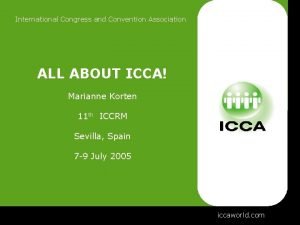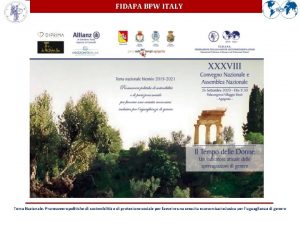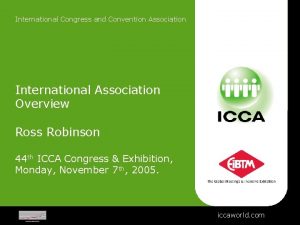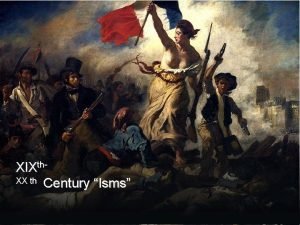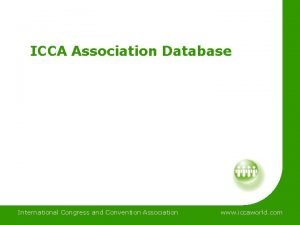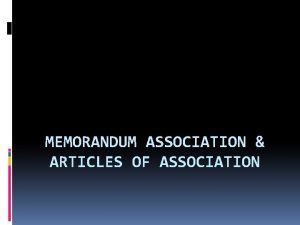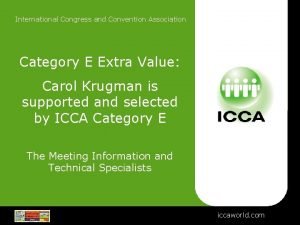XIXth International Congress of the International Association for







































- Slides: 39

XIXth International Congress of the International Association for Cross-Cultural Psychology, July 27 -31, 2008, Bremen, Germany Symposium: Incorporating indigenous psychologies within cross-cultural psychology July 2008 (c) Weinreich 2008: Incorporating emics. . .

Incorporating emics within etic parameters: conceptual and methodological tools Peter Weinreich University of Ulster United Kingdom p. weinreich@ulster. ac. uk July 2008 (c) Weinreich 2008: Incorporating emics. . . 2

Etic/emic dilemma n Etic/emic dilemma: a theory-driven approach n The assessment of psychological dimensions and processes postulated as being cross-cultural universals – etics – given that culturally specific interpretations characterise the indigenous psychologies of local cultures – emics July 2008 (c) Weinreich 2008: Incorporating emics. . . 3

Universal psychological issues: alternative indigenous discourses n Although having recognisable features across cultures, different conceptions of psychological issues - anorexia nervosa, gender and professional identity, primordial sentiments about ethnicity and nationality - will be expressed in alternative discourses peculiar to the respective indigenous psychologies, which may not have immediately translatable equivalents across cultures July 2008 (c) Weinreich 2008: Incorporating emics. . . 4

‘Self’ and ‘identity’ as fundamental features of being-in-the-world n Notions of self and identity exist universally across cultures, but how ‘self’ and ‘identity’ are manifested differs greatly from culture to culture n What elements constitute ‘self’ and ‘identity’ range from highly individualistic values and beliefs (Western) to ‘self’ embedded in kin networks and ‘identity’ specified by position within specific kinship relationships (South Asian) July 2008 (c) Weinreich 2008: Incorporating emics. . . 5

Tools for assessing culturally specific self and identity processes n The conceptual and methodological tools of the Identity Structure Analysis (ISA) conceptual framework n Weinreich, P. , & Saunderson, W. (Eds. ) (2003) Analysing Identity: Cross-Cultural, Societal and Clinical Contexts. London & New York: Routledge/Taylor & Francis July 2008 (c) Weinreich 2008: Incorporating emics. . . 6

Etics incorporating emics n ISA: a natural and practical integration of the emic with the etic (etics incorporating emics) n for which ethnographic input about indigenous psychologies is fundamental July 2008 (c) Weinreich 2008: Incorporating emics. . . 7

Key concepts n The foundations of ISA derive from a number of extant theoretical approaches to the developmental and social psychology of issues of self and identity July 2008 (c) Weinreich 2008: Incorporating emics. . . 8

q Psychodynamic approach…identity over the lifespan through identifications q Symbolic Interactionism…identity through communication q Self-Concept, Social Identity and Self-Esteem…identity through society q Construal and Appraisal…identity by way of idiosyncratic personal constructions q Cognitive-affective Consistency Theory…identity subject to emotional and cognitive pressures q Social Anthropology and Indigenous Psychologies…identity located in cultural context q The fundamental issue of ‘agency’ : Rom Harré – the agentic self July 2008 (c) Weinreich 2008: Incorporating emics. . . 9

ISA concepts n Macro concepts, such as ‘identity’ and aspects of identity, such as ‘ethnic identity’ and ‘gender identity’ n Micro concepts, such as ‘elemental identification’, ‘aspirational identification’ and ‘ego-involvement’ with some other July 2008 (c) Weinreich 2008: Incorporating emics. . . 10

Definition of identity (macro) n A person's identity is defined as the totality of one's self-construal, in which how one construes oneself in the present expresses the continuity between how one construes oneself as one was in the past and how one construes oneself as one aspires to be in the future July 2008 (c) Weinreich 2008: Incorporating emics. . . 11

Definition of ethnic identity (macro) n One’s ethnic identity is defined as that part of the totality of one’s self-construal made up of those dimensions that express the continuity between one’s construal of past ancestry and one’s future aspirations in relation to ethnicity July 2008 (c) Weinreich 2008: Incorporating emics. . . 12

Definition of elemental identification (micro) n An elemental identification is defined as being an identity of a characteristic attributed to the other and experienced in oneself n This definition holds for any culture, i. e. , crossculturally universal (etic) It is simultaneously culturally specific (‘characteristic’ is emic) n July 2008 (c) Weinreich 2008: Incorporating emics. . . 13

Identification with another: two modes n Aspirational – identification over the longer term, in respect of desired or unwanted characteristics (two aspects) n Empathetic – identification in the immediate here and now, as manifested in one context after another (context sensitive) July 2008 (c) Weinreich 2008: Incorporating emics. . . 14

Definition of aspirational identification: aspect 1 n Definition of idealistic-identification with another (micro) n The extent of one’s idealistic-identification with another is defined as the similarity between the qualities one attributes to the other and those one would like to possess as part of one’s ideal self-image July 2008 (c) Weinreich 2008: Incorporating emics. . . 15

Definition of aspirational identification: aspect 2 n Definition of contra-identification with another (micro) n The extent of one’s contra-identification with another is defined as the similarity between the qualities one attributes to the other and those from which one would wish to dissociate July 2008 (c) Weinreich 2008: Incorporating emics. . . 16

Definition of empathetic identification with another (micro) n The extent of one’s current empathetic identification with another is defined as the degree of similarity between the qualities one attributes to the other, whether ‘good’ or ‘bad’, and those of one’s current self-image n May modulate according to context July 2008 (c) Weinreich 2008: Incorporating emics. . . 17

Integration of the emic and the etic n The definitions are cross-culturally universal (etic) and are parameters standardised to range from zero (no identification) through to unity (complete identification) n They also incorporate the culturally specific (emic) characteristics that characterise indigenous values and beliefs July 2008 (c) Weinreich 2008: Incorporating emics. . . 18

Indigenous psychologies n All cultures possess ‘indigenous psychologies’ that are the working dominant understandings that underpin people’s everyday interactions and communications n [These may be investigated scientifically within a culture, giving rise to ‘scientific’ formulations of indigenous psychologies] July 2008 (c) Weinreich 2008: Incorporating emics. . . 19

Ethnographic discourses n In South Asian cultures ‘izaat’ and ‘caste’ are summary terms for the complex indigenous psychological imperatives of everyday relationships that are central to conceptions of self and identity - they have no direct psychological or societal equivalents in western cultures n No straightforward translation and backtranslation for these terms is possible July 2008 (c) Weinreich 2008: Incorporating emics. . . 20

Incorporating emic discourses n In the example of South Asian cultures, the ISA definitions directly incorporate people’s emic discourses around ‘izaat’ and ‘caste’, as they are used to characterise both themselves and others in the community (whether appraised favourably or unfavourably) n With the ISA approach, no translation of ‘izaat’ and ‘caste’ discourses is necessary for scalar etic parameters of identity July 2008 (c) Weinreich 2008: Incorporating emics. . . 21

Etic parameters n If the ISA definitions reference emic characteristics, how is it possible that they can at the same time be etic? Are they not simply culturally specific? n They are indeed culturally specific in terms of their incorporation of emic characteristics of indigenous psychologies n However, as parameters they are standardised to etic scales July 2008 (c) Weinreich 2008: Incorporating emics. . . 22

Example: empathetic identification with another n Recap: The extent of one’s current empathetic identification with another is defined as the degree of similarity between the qualities one attributes to the other, whether ‘good’ or ‘bad’, and those of one’s current self-image July 2008 (c) Weinreich 2008: Incorporating emics. . . 23

Empathetic identification: Emic qualities – etic parameter n The emic qualities of one’s current self-image constitute the agent’s reference appraisal in a particular social context n The agent appraises the other as possessing various qualities that may or may not overlap with those of one’s current self-image July 2008 (c) Weinreich 2008: Incorporating emics. . . 24

Etic standardisation n When there is no overlap between self-appraisal and appraisal of the other, then (according to the ISA definition) the agent has no empathetic identification with the other, which is therefore indicated by zero n When the overlap is total, the agent empathetically identifies with the other completely, which is indicated by unity July 2008 (c) Weinreich 2008: Incorporating emics. . . 25

Etic scalar properties n Generally, an agent’s empathetic identification with another will be somewhere between zero and unity (between 0. 00 and 1. 00), such that, for example, 0. 75 would indicate that the agent empathetically identifies quite closely with the other, whereas 0. 25 would represent only a small degree n The standardised etic parameter (with emic content) ranges from 0. 00 to 1. 00 July 2008 (c) Weinreich 2008: Incorporating emics. . . 26

Example of moderate empathetic identification with father (South Asia) n In Mumbai a Hindu son has adopted some up-to-date ideas about marriage partners, agreeing to an arranged marriage only on condition that he is able to get to know and approve personally the prospective woman concerned, that is, without supervision. This would be an instance of only moderate empathetic identification (say, 0. 65) with his traditional father, with whom he shares other attributes July 2008 (c) Weinreich 2008: Incorporating emics. . . 27

Example of moderate empathetic identification with father (Great Britain) n In London a secular son is living with his longterm partner without getting married, while his devout Christian father believes in the sanctuary of marriage. As with the Mumbai case, he moderately empathetically identifies (again, say, 0. 65) with his traditional father, in terms of other shared attributes July 2008 (c) Weinreich 2008: Incorporating emics. . . 28

Mumbai compared with London: son’s empathetic identification with father n The emic aspect of empathetic identification is evident in both cases in accordance with the respective indigenous psychologies of mainstream peer cultures in Mumbai and London n In both instances, a similar intergenerational difference is evident, indicated by the scalar etic parameter denoting the same, only moderate, degree of empathetic identification with father July 2008 (c) Weinreich 2008: Incorporating emics. . . 29

Integration of the emic (content) with the etic (scalar parameter) n On the basis of theorising about processes of identity development in biographical and socio-historical context, the ISA approach is theory driven. It thereby provides etic concepts (such as empathetic identification with another) that are unambiguously defined, which place emic values and beliefs at the centre of the conceptualisation. Internal standardisation procedures enable etic parameters that have scalar cross-cultural comparability July 2008 (c) Weinreich 2008: Incorporating emics. . . 30

Further ISA concepts in respect of ‘entities’ n n n Conflicted identification with another Identity diffusion (overall extent and spread of conflicted identifications with others) Ego-involvement with another Evaluation of another Ego-involvement with self Evaluation of self July 2008 (c) Weinreich 2008: Incorporating emics. . . 31

Further ISA concepts in respect of ‘constructs’ n n n Polarity of a construct (indicating which of contrasting discourses is favoured) Structural pressure on a construct (referencing compatibilities between cognition and affect maintaining stable usage that may be undermined by incompatibilities) Emotional significance of a construct July 2008 (c) Weinreich 2008: Incorporating emics. . . 32

ISA process postulates n n n Being a theoretical conceptualisation about identity processes, ISA provides a series of postulates about: Appraisal and reappraisal of self and others Benign and malign identification processes Resolution of conflicted identifications Change in aspirations, values and beliefs over time July 2008 (c) Weinreich 2008: Incorporating emics. . . 33

Powering ISA in practice n After appropriate ethnographic work in the targeted culture, a customised ‘identity instrument’ is created which consists of emic ‘themes’ and significant ‘domains’ of self, others, groups, agents and institutions n ‘Themes’ are evoked in terms of emic discourses and texts, presented as ‘bipolar constructs’ n ‘Domains’ are represented by appropriate ‘entities’ July 2008 (c) Weinreich 2008: Incorporating emics. . . 34

Emic appraisal of self and others n By way of the customised identity instrument, the participant uses the emic discourses (constructs) to appraise and characterise self and others (entities) n Construal of one’s ideal self indicates the characterisations to which the person aspires, thereby providing evidence of favoured discourses – with corresponding evaluative connotations that derive from the person’s biographical experiences within the relevant indigenous culture July 2008 (c) Weinreich 2008: Incorporating emics. . . 35

‘Culture’ as societal process n n Evaluative connotations of discourses are empirically assessed for each individual: they are not assumed or imposed by the investigator Hence, as well as being sensitive to the discourses of indigenous psychologies, ISA is able to ascertain alternative perspectives within a community, as when cultural values and beliefs are debated and changes occur over time July 2008 (c) Weinreich 2008: Incorporating emics. . . 36

ISA in practice: algorithms for ISA concepts n All ISA definitions of psychological concepts are translated into algorithms that are isomorphic with the definitions n Customised identity instruments enable participants to appraise their social worlds within the context of an indigenous psychology (emic) July 2008 (c) Weinreich 2008: Incorporating emics. . . 37

ISA in practice: ‘ipseus’ computer software n n n The dedicated ipseus software uses the algorithms to: Operationalise the ISA concepts (e. g. , empathetic identification with another) to become parameters of identity, the magnitudes of which are ascertained for each person Internally standardise, to each person’s particular usage of discourses, the etic scalar properties for each parameter July 2008 (c) Weinreich 2008: Incorporating emics. . . 38

Conclusion & References n ISA provides robust and sensitive tools for ascertaining identity processes in terms of etic parameters of identity that embody emic values and beliefs n Weinreich, P. , & Saunderson, W. (Eds. ) (2003) Analysing Identity: Cross-Cultural, Societal and Clinical Contexts. London & New York: Routledge/Taylor & Francis n Weinreich, P. , & Ewart, S. (2007) ipseus computer software for identity exploration. Belfast: Sycadex Ltd n www. identityexploration. com July 2008 (c) Weinreich 2008: Incorporating emics. . . 39
 International congress and convention association
International congress and convention association Tema nazionale fidapa
Tema nazionale fidapa International chemical congress of pacific basin societies
International chemical congress of pacific basin societies Fspos
Fspos Typiska drag för en novell
Typiska drag för en novell Tack för att ni lyssnade bild
Tack för att ni lyssnade bild Vad står k.r.å.k.a.n för
Vad står k.r.å.k.a.n för Varför kallas perioden 1918-1939 för mellankrigstiden
Varför kallas perioden 1918-1939 för mellankrigstiden En lathund för arbete med kontinuitetshantering
En lathund för arbete med kontinuitetshantering Personalliggare bygg undantag
Personalliggare bygg undantag Personlig tidbok
Personlig tidbok Anatomi organ reproduksi
Anatomi organ reproduksi Densitet vatten
Densitet vatten Datorkunskap för nybörjare
Datorkunskap för nybörjare Boverket ka
Boverket ka Debattartikel struktur
Debattartikel struktur Delegerande ledarstil
Delegerande ledarstil Nyckelkompetenser för livslångt lärande
Nyckelkompetenser för livslångt lärande Påbyggnader för flakfordon
Påbyggnader för flakfordon Lufttryck formel
Lufttryck formel Offentlig förvaltning
Offentlig förvaltning Kyssande vind analys
Kyssande vind analys Presentera för publik crossboss
Presentera för publik crossboss Argument för teckenspråk som minoritetsspråk
Argument för teckenspråk som minoritetsspråk Vem räknas som jude
Vem räknas som jude Treserva lathund
Treserva lathund Fimbrietratt
Fimbrietratt Bästa kameran för astrofoto
Bästa kameran för astrofoto Centrum för kunskap och säkerhet
Centrum för kunskap och säkerhet Lågenergihus nyproduktion
Lågenergihus nyproduktion Bra mat för unga idrottare
Bra mat för unga idrottare Verktyg för automatisering av utbetalningar
Verktyg för automatisering av utbetalningar Rutin för avvikelsehantering
Rutin för avvikelsehantering Smärtskolan kunskap för livet
Smärtskolan kunskap för livet Ministerstyre för och nackdelar
Ministerstyre för och nackdelar Tack för att ni har lyssnat
Tack för att ni har lyssnat Referat mall
Referat mall Redogör för vad psykologi är
Redogör för vad psykologi är Borstål, egenskaper
Borstål, egenskaper Tack för att ni har lyssnat
Tack för att ni har lyssnat
